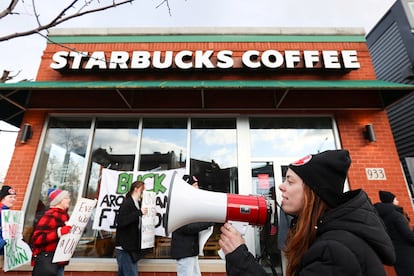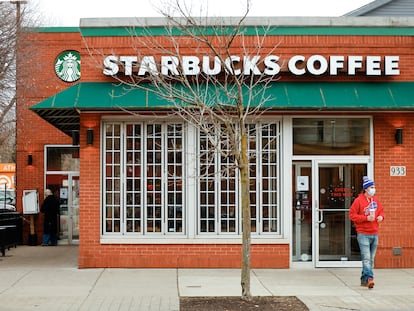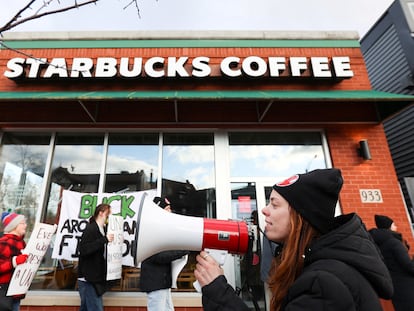Thousands of Starbucks workers are expected to go on a one-day strike
The company opposes the unionization effort and has yet to reach a labor agreement with any of the stores that have voted to unionize

Thousands of workers at more than 200 U.S. Starbucks stores plan to walk off the job Thursday in what organizers say is the largest strike yet in the two-year-old effort to unionize the company’s stores.
The Workers United union chose Starbucks’ annual Red Cup Day to stage the walkout since it’s usually one of the busiest days of the year. Starbucks expects to give away thousands of reusable cups Thursday to customers who order holiday drinks.
The union said it was expecting more than 5,000 workers to take part in its “Red Cup Rebellion.” Around 30 stores also staged walkouts on Wednesday.
Neha Cremin, a Starbucks barista in Oklahoma City, said she was striking to protest understaffing in stores, especially during promotions like Red Cup Day. Cremin said workers are already overwhelmed filling delivery orders, drive-thru orders, mobile orders and in-store orders; promotions add another layer of stress.
“Understaffing hurts workers and also creates an unpleasant experience for customers,” Cremin said. “Starbucks has made it clear that they won’t listen to workers, so we’re advocating for ourselves by going on strike.”
Thursday’s strike was the fifth major labor action by Starbucks workers since a store in Buffalo, New York, became the first to unionize in late 2021. Workers at 110 stores walked out last year on Red Cup Day; most recently, a strike in June protested reports that Starbucks had removed Pride displays from its stores.
But the strikes have had little impact on Starbucks’ sales. For its 2023 fiscal year, which ended Oct. 1, Starbucks reported its revenue rose 12%,to a record $36.0 billion.
Starbucks downplayed any potential impact of the strike Wednesday, saying it would occur at a “small subset” of the company’s 9,600 company-owned U.S. stores.
“We remain committed to working with all partners, side-by-side, to elevate the everyday, and we hope that Workers United’s priorities will shift to include the shared success of our partners and negotiating contracts for those they represent,” Starbucks said in a statement.
At least 363 company-operated Starbucks stores in 41 states have voted to unionize since late 2021. The Starbucks effort was at the leading edge of a period of labor activism that has also seen strikes by Amazon workers, auto workers and Hollywood writers and actors. At least 457,000 workers have participated in 315 strikes in the U.S. just this year, according to Johnnie Kallas, a Ph.D. candidate and the project director of Cornell University’s Labor Action Tracker.
Starbucks opposes the unionization effort and has yet to reach a labor agreement with any of the stores that have voted to unionize. The process has been contentious; regional offices with the National Labor Relations Board have issued 111 complaints against Starbucks for unfair labor practices, including refusal to bargain. Starbucks says Workers United is refusing to schedule bargaining sessions.
Starbucks noted that it has started bargaining with the Teamsters union, which organized a Starbucks store outside of Pittsburgh in June 2022. But the two sides have not reached a labor agreement. The Teamsters didn’t say Wednesday whether workers at the unionized store would also be striking.
Relations between Starbucks and Workers United have grown increasingly tense. Last month, Starbucks sued Workers United, saying a pro-Palestinian post on a union account damaged its reputation and demanding that the union stop using the name Starbucks Workers United. Workers United responded with its own lawsuit, saying Starbucks defamed the union by suggesting it supports terrorism and violence.
Sign up for our weekly newsletter to get more English-language news coverage from EL PAÍS USA Edition
Tu suscripción se está usando en otro dispositivo
¿Quieres añadir otro usuario a tu suscripción?
Si continúas leyendo en este dispositivo, no se podrá leer en el otro.
FlechaTu suscripción se está usando en otro dispositivo y solo puedes acceder a EL PAÍS desde un dispositivo a la vez.
Si quieres compartir tu cuenta, cambia tu suscripción a la modalidad Premium, así podrás añadir otro usuario. Cada uno accederá con su propia cuenta de email, lo que os permitirá personalizar vuestra experiencia en EL PAÍS.
¿Tienes una suscripción de empresa? Accede aquí para contratar más cuentas.
En el caso de no saber quién está usando tu cuenta, te recomendamos cambiar tu contraseña aquí.
Si decides continuar compartiendo tu cuenta, este mensaje se mostrará en tu dispositivo y en el de la otra persona que está usando tu cuenta de forma indefinida, afectando a tu experiencia de lectura. Puedes consultar aquí los términos y condiciones de la suscripción digital.
More information
Archived In
Últimas noticias
Venezuelan migrants contribute billions of dollars to Latin America, but continue to work in the informal sector
Ecuadorian soccer under attack from organized crime: Five players murdered in 2025
Water, a ticking time bomb for Mexico
Christmas Eve for Christians in Gaza: Confinement, no toys, and explosions near the church
Most viewed
- Christian Louboutin: ‘Young people don’t want to be like their parents. And if their parents wear sneakers, they’re going to look for something else’
- Cartels in Mexico take a leap forward with narco-drones: ‘It is criminal groups that are leading the innovation race’
- ‘El Limones’ and the growing union disguise of Mexican organized crime
- Liset Menéndez de la Prida, neuroscientist: ‘It’s not normal to constantly seek pleasure; it’s important to be bored, to be calm’
- The low-cost creative revolution: How technology is making art accessible to everyone










































